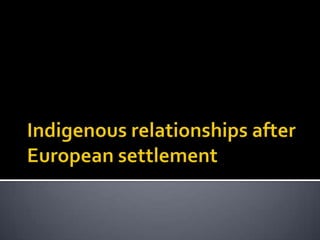
Indigenous relationships after european settlement
- 2. Questions: We have looked at Aboriginal relationships with the land. Did these remain the same once European settlers arrived? How did they change? Why did they change? How are the different today?
- 3. Significant changes occurred in the way that Aborigines in the Gippsland area lived after white settlement. In order to understand and describe these, it is important to try and put ourselves in the position of what it would have been like to be an Aborigine in Gippsland in the mid 1800’s. In order to do this, this account is not necessarily the politically correct version of events usually told.
- 4. 13 September 1843 – Gippsland Pronounced a district. Named after NSW Governor Gipps who commissioned the first detailed exploration of the area by Paul Strzelecki. Reports at this time by Crown Land’s Commissioner James Tyers estimate 1800 (may have been 3000) local aborigines. His 1857 (14 years later) estimated there were 96 surviving members of this tribe. Common historical explanations: Disease, displacement, tribal warfare, alcohol.
- 5. 1861 – Lake Tyers Mission established to ‘look after’ remaining Aborigines in area. Residents provided with rations but allowed to continue hunting practices within mission. Children received religious education as well as sewing and cooking for girls, and trades, like carpentry for boys. 1880’s – Gippsland lakes become popular with tourists – often visiting the mission. Residents make and seel artefacts to promote economic independace. 1917 – concentration policy. All remaining aborigines in Gippsland moved to Lake Tyers. 1971 – 4000 acres at Lake Tyers returned to local Aboriginal population.
- 6. Was there tribal warfare? Yes. Some. Mainly due to breaking down of traditional tribal boundaries. Conflict between blacks and whites? Kurnai people may have been more fierce and resisted more strongly than Port Phillip Bay tribes. Resisted by spearing sheep and cattle and occasionally attacking homes. Common view of local Aborigines as ‘pests’. Treated the same way a wild animal that had been killing stock would.
- 7. “No wild beast of the forest was ever hunted down with such unsparing perseverance as they are. Men, women, and children are shot whenever they can be met with. Some excuse might be found for shooting the men by those who are daily getting their cattle speared, but what they can urge in their excuse who shoot the women and children I cannot conceive. I have protested against it at every station I have been in Gippsland, but these things are kept very secret as the penalty would certainly be hanging”. Henry Merryck
- 8. "if I caught a black actually killing my sheep, I would shot him with as little remorse as I would a wild dog".
- 9. Angus Mcmillan was the most prominent explorer of Gippsland in the mid 1800’s In 1840 he published a letter in the Melbourne ‘Argus’ describing an event where his exploring party came across a group of Aborigines who had captured a white woman. No evidence of this woman was ever found. There were very few women in Gippsland at the time. McMillan later led an expedition to locate the women. In 1847 McMillan claimed he had found the body of the woman. For 7 years, local settlers had an excuse, and even a ‘duty’ to murder any aborigine they cam across. The irony is, that while settlers were raping local aboriginal women, the possibility that a white woman had ben captured convinced them they had a noble cause.
- 10. In 1843, Ronald Macalister – a prominent settler was killed by a group of Aborigines. Evidence suggests another settler shot a group of aboriginal men while drunk, and that Macalister was shot in a revenge attack. An official report describes that the local population was ‘completely dispersed’. What do you think this means?
- 11. “every scotchman with a horse and gun gathered” – likely led by Angus McMillan. A large camp of aborigines at Warrigal Creek, near 90 mile beach was surrounded and fired upon. Some escaped or jumped into the waterhole, but were shot as soon as they surfaced. A 12 year old boy, who had ben shot in the face, was captured and forced to lead the party to other camps to find any who had escaped. 100-150 aborigines were killed.
- 12. James Tyers, the first commissioner of Gippsland, never once referred specifically to a white man who had killed a black man. Example. In 1844 after some cattle had been speared, Tyers writes: “Mr McMillan and other pursed them and came up with them on the Ranges - Blacks poised their spears - party fired - not known if any blacks were killed. Number of blacks said to be 200." What do you think happened?
- 13. Early settlers had many laws to govern their society. However, in the example mentioned above, 2 magistrates were present! Local black population not considered part of the new society. “Terra Nullius” view still very common.
- 14. Consider the Aboriginal relationship with the land before white settlement – we have looked at this in detail. Would the way they imagined their role in 1880 be different? Are any of the land management techniques we looked at still being used by this population? Discuss. What new actions might these people be doing? How might this affect the way they see their role?
- 15. Go back to the story you wrote about your brother becoming a DJ. Try to imagine the feelings you may have had. Edit the story. Change the events to make it an account of an early aborigine during European settlement. Try and keep the emotions in the story the same.